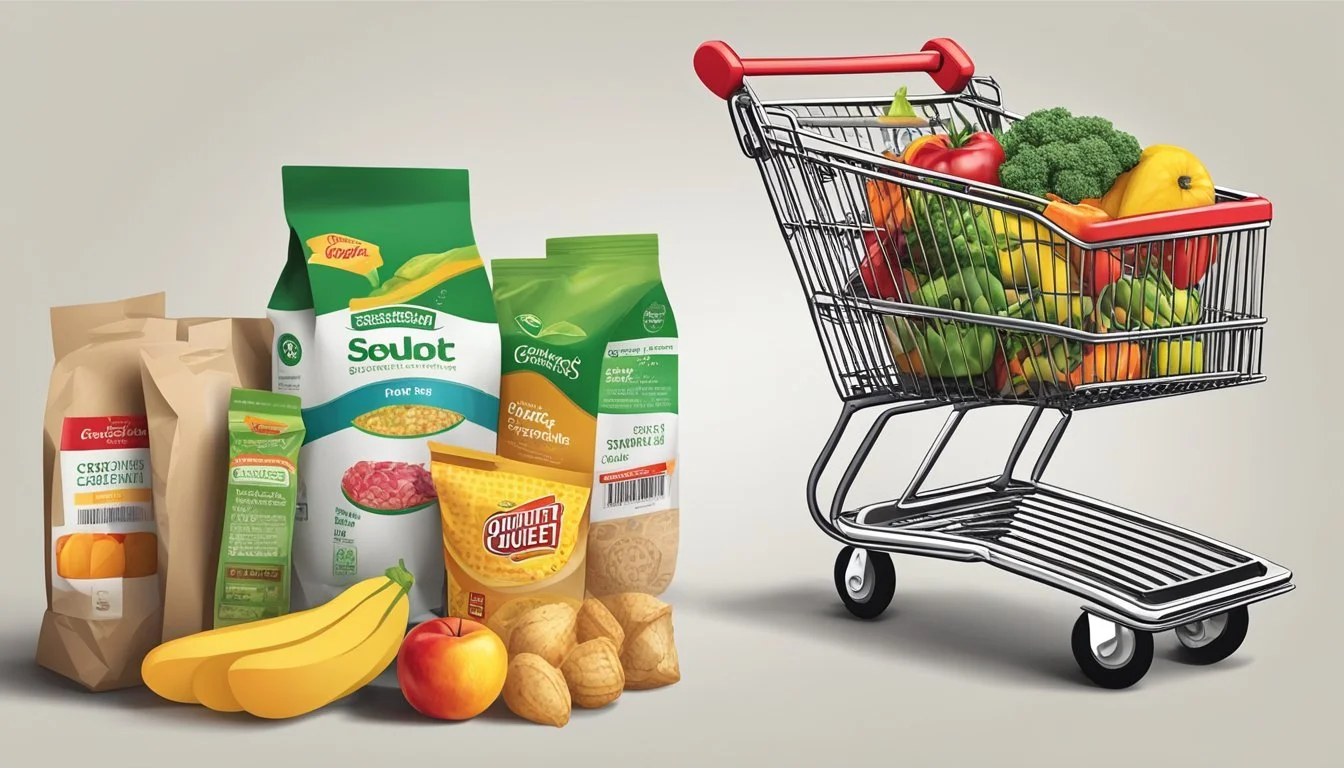Is Grocery Outlet Cheaper Than Walmart?
A Price Comparison Study
Grocery prices have been a significant concern for many shoppers in recent years, with food costs rising substantially since 2020. As consumers seek ways to stretch their budgets, comparing prices between different stores has become increasingly important.
Grocery Outlet generally offers lower prices than Walmart on many items, with potential savings of up to 70% compared to other supermarkets. This discount grocery chain specializes in selling overstock, closeout, and discontinued products at deeply discounted prices. While Walmart is known for its everyday low prices, Grocery Outlet's unique business model often allows it to undercut even Walmart's prices on certain products.
Both stores have their strengths when it comes to value. Walmart's consistent pricing and wider selection make it a reliable choice for many shoppers. Grocery Outlet, on the other hand, offers more unpredictable but often deeper discounts on a rotating selection of items. The best choice for budget-conscious consumers may depend on individual shopping habits and the specific products needed.
Overview of Grocery Outlet and Walmart
Grocery Outlet and Walmart are major players in the U.S. retail grocery market. Both aim to offer low prices, but their business models and store footprints differ significantly.
Business Models and Operating Strategies
Grocery Outlet operates as a discount grocery chain, focusing on opportunistic buying of surplus inventory. The company purchases excess stock from national brands at steep discounts, passing savings to customers. Prices at Grocery Outlet can be up to 70% lower than traditional supermarkets.
Walmart, in contrast, leverages its massive scale to negotiate low prices from suppliers. The retail giant stocks a wide variety of products beyond groceries, including electronics, clothing, and home goods. Walmart's everyday low price strategy aims to consistently undercut competitors across product categories.
Market Presence and Location Distribution
Walmart boasts a vast network of over 4,700 stores across the United States. Its locations include large supercenters, smaller neighborhood markets, and Sam's Club warehouse stores. Walmart stores can be found in both urban and rural areas, often serving as anchor tenants in shopping centers.
Grocery Outlet has a more limited footprint, with approximately 400 stores concentrated primarily in the western United States. The chain is expanding into new markets but remains focused on specific regions. Grocery Outlet stores are typically smaller than Walmart supercenters, averaging around 15,000 square feet compared to Walmart's 180,000 square feet.
Price Comparison and Saving Opportunities
Grocery Outlet and Walmart both offer competitive pricing on common household items. Each store employs unique strategies to attract budget-conscious shoppers and provide savings opportunities.
Common Items Price Analysis
Grocery Outlet prices are approximately 26% lower than the national average, while Walmart's prices are about 20% less. This difference can result in significant savings for shoppers over time.
A comparison of specific items reveals varied results. Almond butter, for example, is $1.09 cheaper at Grocery Outlet compared to Walmart for the same 12-ounce jar.
To determine the best value, shoppers should compare prices on their most frequently purchased items at both stores. Prices can fluctuate based on location, season, and supply chain factors.
Discounts and Sales Strategies
Both retailers use distinct approaches to offer discounts and attract customers. Walmart is known for its "rollback" program, which temporarily reduces prices on select items.
Grocery Outlet, on the other hand, specializes in selling overstock and discontinued items at discounted rates. This strategy allows them to offer deep discounts on brand-name products.
Loss leaders, items sold at or below cost to attract customers, are used by both stores. These can include staples like milk, bread, or eggs.
Sale prices at both retailers can provide substantial savings. Shoppers should check weekly ads and in-store promotions to maximize their savings potential.
Impact of Suppliers and Inventory on Prices
Grocery Outlet's unique business model of purchasing excess inventory from suppliers allows them to offer steep discounts on brand-name products. This approach results in a constantly changing inventory.
Walmart's vast network of suppliers and efficient supply chain management contribute to its consistently low prices across a wide range of products.
The availability and pricing of fresh produce and perishables can vary between the two stores. Walmart's larger scale often allows for more consistent pricing on these items.
Seasonal fluctuations and market conditions can affect prices at both retailers. Shoppers may find better deals on certain items at different times of the year.
Product Selection and Quality
Grocery Outlet and Walmart differ significantly in their product offerings and quality. Both stores cater to budget-conscious shoppers but take distinct approaches to selection and sourcing.
Availability of Budget and Premium Brands
Grocery Outlet specializes in discounted overstock and closeout items from name-brand manufacturers. This results in an ever-changing inventory of premium products at reduced prices. Shoppers can find high-end labels alongside budget options, but selection is unpredictable.
Walmart, in contrast, maintains a consistent stock of both national brands and its own Great Value line. The retail giant's buying power allows it to offer competitive prices on staples and popular items. Walmart's shelves feature a wider range of choices in most categories, from economy to premium.
Freshness and Quality of Perishables
Produce quality can vary at Grocery Outlet due to its opportunistic buying model. Some locations offer excellent deals on fresh fruits and vegetables, while others may have limited options or items nearing expiration.
Walmart's produce section is typically more extensive and reliable. The store's high turnover helps ensure fresher items. Meat departments at Walmart stock a variety of cuts and grades, catering to different preferences and budgets.
Organic and Health-Focused Options
Grocery Outlet has increased its organic and natural food offerings in recent years. Shoppers can find discounted organic produce and health-focused brands, though availability fluctuates.
Walmart has expanded its organic selection significantly, now carrying a broad range of USDA-certified organic products. The store's size allows for dedicated sections of health-conscious items, including gluten-free, vegan, and non-GMO options.
Both retailers aim to meet growing demand for healthier choices, but Walmart's scale provides more consistent access to these products.
Customer Shopping Experience
The customer shopping experience at Grocery Outlet and Walmart differs significantly in terms of store layout, service, and checkout processes. Each retailer offers unique features that cater to different shopping preferences and needs.
Service and Store Layout
Grocery Outlet stores are typically smaller and more compact than Walmart supercenters. This can make navigation easier for customers with specific items on their shopping list. Grocery Outlet's layout often emphasizes their bargain finds and rotating inventory.
Walmart's larger format provides a wider selection but may require more time to locate items. Their stores usually have clearly marked aisles and departments to assist shoppers.
Service levels can vary between locations for both retailers. Grocery Outlet often has a more personalized feel, with staff readily available to assist customers. Walmart employs a larger workforce but may have busier stores, potentially impacting individual service interactions.
Convenience Features and Checkout Process
Walmart offers several convenience features that enhance the shopping experience. Many locations provide self-checkout options, reducing wait times during peak hours. Their mobile app allows customers to create shopping lists and find item locations in-store.
Grocery Outlet's checkout process is generally more traditional, with cashier-operated lanes. This can lead to a more personal interaction but may result in longer wait times during busy periods.
Walmart's size enables them to offer additional services like pharmacies and vision centers, making it possible for customers to complete multiple errands in one trip. Grocery Outlet focuses primarily on grocery and household items, which can lead to a more streamlined shopping experience for those seeking only these products.
Assessing Consumer Value
Price comparisons only tell part of the story when evaluating grocery stores. Consumer value encompasses factors beyond just cost, including product quality, selection, and shopping experience.
Brand Loyalty and Customer Preferences
Grocery Outlet has cultivated a loyal following among bargain hunters. Many shoppers appreciate its ever-changing inventory of discounted name-brand items. This unpredictable selection creates a "treasure hunt" atmosphere some find exciting.
Walmart, in contrast, offers consistency. Customers can reliably find the same products week after week. This predictability appeals to those who prefer routine in their shopping habits.
Product quality perceptions vary between the two stores. Some view Grocery Outlet's discounted items as lower quality or nearing expiration. Walmart's reputation for everyday low prices on fresh items may give it an edge for certain shoppers.
Budget Impact Analysis for Families
For families with a set grocery budget, the choice between Grocery Outlet and Walmart can significantly impact their bottom line. A typical family spending $250 per week on groceries might see notable savings at either store compared to traditional supermarkets.
Grocery Outlet's deeper discounts on select items can lead to substantial savings. However, its limited selection may require supplemental shopping elsewhere.
Walmart's one-stop-shop nature allows families to complete all their shopping in a single trip. This convenience factor can reduce impulse purchases and save time.
• Grocery Outlet: Potential for higher savings, but may require multiple store visits • Walmart: Consistent savings across more categories, greater convenience
Comparing Overall Grocery Spending
To accurately assess value, consumers must look beyond individual item prices to their total grocery spend. The ConsumerPedia podcast suggests tracking expenses over several weeks at each store.
Grocery Outlet's irregular inventory means savings can vary widely week-to-week. Shoppers willing to be flexible with their meal planning can maximize discounts.
Walmart's steady pricing allows for more predictable budgeting. Its wider selection reduces the need for additional shopping trips, potentially lowering overall costs.
Factors affecting total spend:
Gas and time costs for multiple store visits
Availability of store-brand alternatives
Produce quality and shelf life
Bulk purchase options
Comparative Analysis of Additional Benefits
Grocery Outlet and Walmart offer distinct perks beyond just low prices. These additional benefits can significantly impact the overall shopping experience and potential savings for customers.
Membership Offers and Exclusive Deals
Walmart provides a membership program called Walmart+ that offers several benefits. For $98 per year or $12.95 monthly, members get free shipping on orders, free grocery delivery, fuel discounts, and early access to special promotions. In contrast, Grocery Outlet does not have a membership program.
Walmart frequently runs sales and offers rollback prices on various items. Their app features digital coupons and a savings catcher tool. Grocery Outlet, on the other hand, focuses on everyday low prices rather than sales or coupons. They offer a "WOW" deals section with limited-time discounts on select products.
Target's Circle program and Amazon's Prime member deals provide stiff competition in this area, offering additional savings and perks to their loyal customers.
Grocery Delivery and Online Shopping
Walmart excels in online shopping and delivery options. They offer grocery pickup for free and same-day delivery for a fee or free with Walmart+. Their website and app allow customers to easily browse and order items for delivery or pickup.
Grocery Outlet lacks robust online shopping capabilities. They do not offer grocery delivery or pickup services in most locations. This limitation can be significant for customers who value convenience or have mobility issues.
Amazon's Prime grocery delivery from Whole Foods and Target's same-day delivery through Shipt present strong alternatives in this category. Aldi has also expanded its delivery options in recent years, partnering with Instacart in many locations.
Market Trends and Consumer Behavior
Economic shifts and changing demographics are reshaping how consumers approach grocery shopping. Price sensitivity and evolving preferences drive new patterns in store selection and purchasing habits.
Effects of Economic Changes on Shopping Habits
Inflation has pushed many shoppers to seek out lower-priced options. Discount chains like Aldi and Grocery Outlet have seen increased traffic as consumers look to stretch their budgets.
Traditional supermarket chains face pressure to compete on price while maintaining quality. Some have expanded their private label offerings to provide more affordable alternatives.
Walmart has leveraged its scale to keep prices low, attracting budget-conscious shoppers. The retail giant reports strong sales despite economic headwinds.
Many consumers now split their shopping between multiple stores to find the best deals. This "cherry-picking" behavior challenges retailers to differentiate themselves beyond just price.
Adaptation to New Demographics and Preferences
Younger shoppers and diverse populations are driving demand for expanded product selections. Ethnic foods, plant-based options, and locally sourced items have gained prominence in many stores.
Convenience is increasingly important, with growth in online ordering and delivery services. Retailers are investing in digital platforms and fulfillment capabilities to meet this need.
Health-conscious consumers seek out organic and natural products. Even discount chains have expanded these offerings to capture this market segment.
Sustainability concerns influence purchasing decisions for some shoppers. Retailers have responded by highlighting eco-friendly packaging and ethical sourcing practices.
Store formats are evolving, with some chains experimenting with smaller urban locations or specialized concept stores to target specific demographics.
Conclusion
Grocery Outlet and Walmart both offer competitive pricing for budget-conscious shoppers. Grocery Outlet's prices tend to be about 26% lower than the national average, while Walmart's are around 20% less.
The key difference lies in product selection. Grocery Outlet specializes in overstocked and closeout items, resulting in a constantly changing inventory. This can lead to significant savings on certain products.
Walmart, on the other hand, provides a more consistent and extensive selection of goods. Its size and buying power allow for regular low prices across a wide range of items.
Choosing between the two depends on individual shopping needs and preferences. Grocery Outlet may offer deeper discounts on specific items, but Walmart provides greater product variety and consistency.
Both stores have their strengths in the budget grocery market. Savvy shoppers might benefit from incorporating both into their shopping routines to maximize savings and product options.





